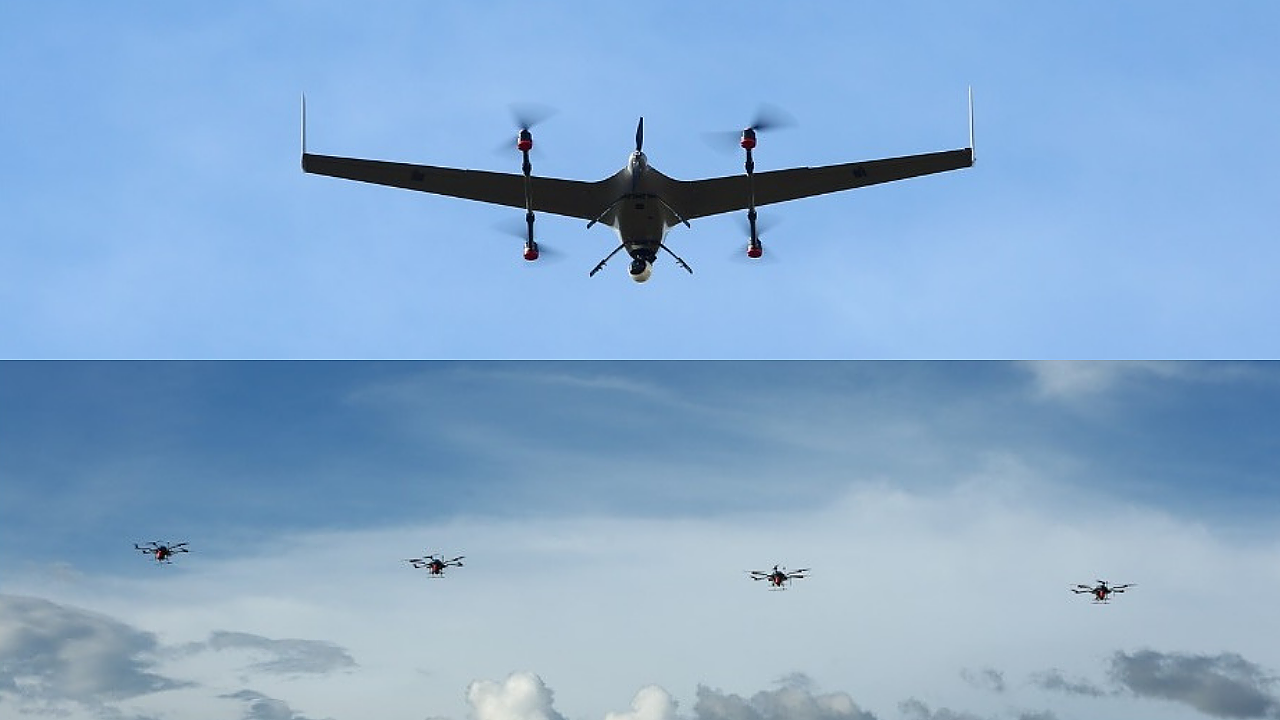
In what is a small but significant moment for the Indian defence production ecosystem, the Indian Air Force (IAF) announced the winners of the first ‘Mehar Baba Swarm Drone Competition’ on Sunday. The winning teams could receive contracts for the supply of swarm drones and an initial co-production order with the IAF’s Base Repair Depot worth up to INR 100 crore. The IAF announced the winners on the last day of the ‘Swarnim Vijay Varsh’ conclave held at Air Force Station (AFS), Yelahanka, to commemorate 50 years since India’s victory in the 1971 Indo-Pak War.
Air Chief Marshal VR Chaudhari presented the trophies to the successful teams. The ‘Award for Best Communication Architecture’ went to Delhi Technological University - Flair Unmanned Systems and the ‘Award for Best Drone Architecture’ to Dhaksha Unmanned Systems from Anna University, Chennai. Veda Defence Systems, a Noida based start-up, won the ‘Award for Best innovation’ in Design. Bengaluru based start-up Newspace Research Technologies received the ‘Best Swarm Architecture’ award. The competition was open only to indigenous talent and start-ups who had to evolve their proprietary designs for the development, manufacture and production of swarm drone technology to meet the specific requirements of the IAF.

A demonstration of the technology, which can revolutionise future warfare, also took place at AFS Yelahanka on Sunday. The winning teams showcased their swarm drone capabilities in a live demonstration comprised of three different airborne systems – ‘Baaz’ is the airborne controller that observes the area of operation operating alongside ‘Yodha’ multi-copter drones and ‘Ghatak’ killer drones. The Indian Army had carried out a similar live demonstration in January this year, using 75 indigenously designed and developed drones that executed simulated offensive missions and close support tasks.
Innovative Approach
Launched on Air Force Day (October 8th) 2018 as an IAF led initiative, the three-year long swarm drone competition was aimed at unleashing the speed of innovation inherent in start-up firms and the private sector to quickly demonstrate their ability to provide the IAF with “low cost - high impact” swarm drone technology solutions.
The IAF’s maiden swarm drone competition also highlights the growing confidence within the armed forces on partnering with the Indian private sector for advanced technology as compared to the earlier model of cutting-edge defence research being undertaken by the Defence Research & Development Organisation (DRDO) and Defence Public Sector Undertakings (DPSU) such Hindustan Aeronautics Limited (HAL) and Bharat Electronics Limited (BEL). The latter model often involved long development and development cycles, which added cost and delays to the development of new products.
As part of the competition, the IAF sought to develop a portable ground control unit in which a single operator would be present. The drone operator would have to be able to control up to 50 drones. These drones would have to fly up to a distance of 100km while carrying a payload of 1kg. The IAF had also requested that these drones spend up to an hour over a particular area of interest or target. In March, the five finalists showcased their capabilities at the Pokhran test range, where the IAF evaluated the prototypes at their ‘Air to Ground’ ranges. The flying and technical evaluation of the fielded products was carried out in a realistic environment based on the operational requirements and objectives set by the IAF for the competition. IAF bore the design and development cost of their prototypes besides providing mentoring and guidance.

Drone swarms require advanced algorithms and software as the masses of drones of different sizes need to perform coordinated tasks that must cater for sudden changes in weather such as temperature, windspeed, rain/hail, etc. However, since drone swarms for non-military purposes such as disaster relief can make use of commercial platforms, they can gain access to economies of scale simply not possible with military drones that have to clear stringent certification standards and military procurement procedures and are produced in smaller numbers.
Strength In Numbers
While the swarm drones showcased at the event was in a military avatar with the ability to attack enemy targets, they will also have significant uses for the military in the realm of disaster relief and humanitarian aid. The use of conventional aircraft and helicopters often necessitates that these assets operate from their bases or make-shift runways and helipads, which are far from the site where aid is needed. Due to the compact size of drones, a swarm drone system could be based closer to the relief zone and move as per the requirement, with the swarm drones being able to carry and deliver larger aid packages on a more precise basis. This could involve delivering food aid/medicines to flood-affected areas/houses or people stranded in a hilly area due to landslides. Currently, such tasks can only be performed by aircraft or helicopters, which are expensive to operate and maintain and reduce their availability for operational missions of the armed forces.